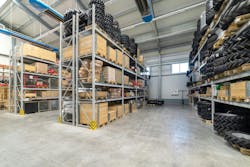Is your facility prepared for hurricane disaster? Tips from a survivor
Key Highlights
- Use your CMMS to manage spare parts inventory, moving beyond spreadsheets for better visibility and control.
- Regularly verify and update your asset hierarchy to ensure data accuracy, which is vital during crises.
- Engage maintenance teams to gather firsthand insights for accurate BOMs and asset management.
- Incorporate decommissioning processes in your CMMS to keep asset data current and relevant.
- Leverage hierarchy data to identify weak links, analyze asset usage, and drive continuous improvement.
In the wake of Hurricane Helene, the difference between downtime and recovery at Baxter Healthcare’s North Cove plant came down to many factors including unbelievable manhours, employee dedication, and community effort. But one important factor that was critical in recovery might not be something you're thinking about during a disaster: data discipline.
When the hurricane shut down the facility, maintenance and reliability teams weren’t just facing a crisis—they were facing a test of their systems. With the facility buried in mud and cut off from power, access to critical equipment data and spare parts lists became the difference between chaos and coordinated recovery.
Armed with a laptop, the computer maintenance management system (CMMS), and a cup of coffee at a cafe with Wi-Fi, Reliability Engineering Superintendent Bobby Lee Gilliam used Baxter’s asset hierarchy and spare parts database to help rebuild what the storm destroyed. To learn more about how Hurricane Helene devastated the facility and how Baxter rebuilt under pressure, read this article. Here, Gilliam’s story is a reminder that reliability isn’t built during a disaster—it’s built in the data discipline, asset hierarchy, and spare parts accuracy that happen long before one.
About a week after Hurricane Helene, Gilliam was hauling supplies from Raleigh to McDowell County in partnership with the fire department to help local folks start to rebuild. On the road, he got a call from his boss, who needed him to come in to do equipment assessments, and “Is there any way that you can try to start building a spare parts list?” Gilliam recalled. Much of the area was still without power and internet. "This is why there's power in a coffee shop," he said, when he pulled off the road into one that still had Wi-Fi. "I was able to go into Maximo and retrieve the spare parts associated."
No spare parts list? Inaccurate asset hierarchy? Here’s where to start
After Hurricane Helene, Gilliam’s team at Baxter Healthcare had to rebuild fast—and their CMMS was one of the critical assets driving the recovery process, even when they couldn’t access equipment buried in mud and water. For maintenance and reliability leaders, the experience highlights a critical truth: reliable data drives reliable performance. Here are Gilliam’s best practices for using your asset hierarchy and spare parts list to strengthen readiness and resilience during regular operating conditions before disaster strikes:
- Move beyond spreadsheets.
“Leverage your CMMS to manage your spare parts inventory. Don’t just have it on a spreadsheet,” Gilliam said. A CMMS provides visibility, control, and connection between parts, assets, and maintenance tasks that static files never could never achieve. - Verify your hierarchy—regularly.
“Do you have a hierarchy process? Do you check it for accuracy?” Gilliam asked. An accurate spare parts list also requires an accurate asset hierarchy in the CMMS. Even the best CMMS won’t deliver results if the hierarchy isn’t maintained and reviewed. - Make sure the data tells the truth.
While any CMMS ultimately can help manage parts and maintenance, the associated parts and PMs need to be entered correctly. “Go out and do a vital check on your assets that are installed in your line,” Giliam said. For example, after an RCA on a failed component, Gilliam’s team found that a project engineer left an asset inactive in the CMMS, which turns the PM off. After repairs, the asset needed to return to active in order for the PM to turn back on. - Go to the equipment experts: your mechanics.
Without a spare parts list, go to the mechanics and ask them what they need to maintain each asset. “That’s a great place to start for a bill of materials,” Gilliam said. “They do not want to spend 30 minutes looking for a part. If they do, they will write it down and they will keep it in a special little black book,” he added. - Don’t forget decommissioning.
Every end-of-life asset should trigger a cleanup in the CMMS. “Create a good decommissioning process and incorporate the removal of spare parts for those assets when they're decommissioned,” Gilliam said. - Put planners in charge of BOM accuracy.
Planners should manage the bill of materials (BOMs) because they see the work firsthand. “They're the ones that are generating your corrective maintenance work orders. They should be walking down these jobs. They should be looking at it and seeing what components they need to build to complete this task,” Gilliam said. - Use hierarchy data to drive improvement.
A solid hierarchy isn’t just for organization—it’s a lens for reliability analysis. “You can start to see the usage. You can start to see what's eating your lunch. What are we going through the most? Should that sensor be failing that often? These are great questions to ask with your asset hierarchy process. It's important to incorporate this into a quality management system,” Gilliam said. Integrate these insights into your quality management system to identify weak links and improve long-term performance.
Ultimately, you can empower mechanics with reliability knowledge, and they will, in turn, better understand why documentation and processes are done a certain way. “What I have to do with those maintenance guys is teach them the reliability engineering principles. They already know the maintenance side. They already know how screwed up their PMs are. I'm just giving them the power and the tools to be better, to make change. I'm taking the handcuffs off, right? ‘You're sick of that sensor eating your lunch every day when you run maintenance, let's do something about it. Let me empower you,’ ” Gilliam said.
Building an accurate asset hierarchy: ISO 14224 best practices (with a Disney twist)
Asset hierarchy does follow an industry standard: International Organization for Standardization (ISO) 14224. The standard hierarchy has nine different levels. One through six represent the location and seven through nine are the assets themselves:
- Industry
- Business Category
- Installation
- Plant/Unit
- Section/System
- Equipment/Unit
- Subunit
- Component/Maintainable Item
- Part
To make the concept of asset hierarchy more approachable, Gilliam turned to a surprising example: Monsters Inc., the Disney/Pixar film from 2001. By mapping the plant’s systems and assets to the movie’s power-generating world, he illustrates how each level of a hierarchy—from industry down to individual parts—creates structure and traceability in real-world (and fictional) operations. Below is the Monster Inc. asset hierarchy and an explanation for each category:
- The industry is simply the market that you are part of, such as pharmaceuticals and Baxter Healthcare. “Monsters Inc., they’re in power generation,” Gilliam said. “That’s what they do. They generate power there to power the city that they live in.”
- The business category represents the branch of industry that you represent, such as fossil fuels or medical devices. “This is kind of dark,” Gilliam said, “but Monsters Inc., they harvest screams, so it’s renewable energy.”
- The installation is the location of the facility. “Monsters Inc. is in Monstropolis,” Gilliam said.
- The plant/unit is the name of the company, or Monsters Inc.
- The section/system are the areas of your facility. In Monsters Inc., this is the production scare floor. “This is where they lock the doors in place. They scare the kids, they get the power, and this is where they do work,” Gilliam said.
- The equipment/unit is associated with the above system, or what makes that system work. “Here, it cannot operate if we do not have a door retrieval and deployment system. We have to have the system in order to get the doors in place,” Gilliam said.
- The subunit is a breakdown of the equipment unit. “Here, we'll look at the overhead conveyance system. This is where they jump on the door and they're riding it through,” Gilliam said.
- The component/maintainable item are the different parts that allow the asset to operate. “Now, we’re talking about the motors,” Gilliam said.
- Each part supports the components in operating. “Here we have the great maintenance guys at Monsters Inc. sitting there, and they're yelling for a shaft, but maybe they can't find the shaft, and they're trying to find it. If your asset hierarch is set up successfully, you can find that shaft. You can find that bearing. You can find that sprocket. You can find what you need to be successful.”
About the Author

Anna Townshend
managing editor
Anna Townshend has been a journalist and editor for almost 20 years. She joined Control Design and Plant Services as managing editor in June 2020. Previously, for more than 10 years, she was the editor of Marina Dock Age and International Dredging Review. In addition to writing and editing thousands of articles in her career, she has been an active speaker on industry panels and presentations, as well as host for the Tool Belt and Control Intelligence podcasts. Email her at [email protected].

